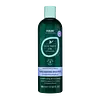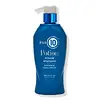What's inside
What's inside
 Key Ingredients
Key Ingredients

No key ingredients
 Benefits
Benefits

 Concerns
Concerns

 Ingredients Side-by-side
Ingredients Side-by-side

Water
Skin ConditioningSodium C14-16 Olefin Sulfonate
CleansingCocamide Mea
EmulsifyingCocamidopropyl Betaine
CleansingGlycerin
HumectantGlycol Distearate
EmollientMelaleuca Alternifolia Leaf Oil
AntioxidantRosmarinus Officinalis Leaf Oil
MaskingMenthol
MaskingPanthenol
Skin ConditioningPolyquaternium-68
Polyquaternium-7
Ethylhexylglycerin
Skin ConditioningPEG-150 Distearate
EmulsifyingGuar Hydroxypropyltrimonium Chloride
Skin ConditioningSodium Hydroxide
BufferingPhenoxyethanol
PreservativeHydroxypropyl Methylcellulose
Emulsion StabilisingSodium Benzoate
MaskingMagnesium Nitrate
Sodium Chloride
MaskingMethylisothiazolinone
PreservativeMethylchloroisothiazolinone
PreservativeCitric Acid
BufferingMagnesium Chloride
Parfum
MaskingLimonene
PerfumingLinalool
PerfumingWater, Sodium C14-16 Olefin Sulfonate, Cocamide Mea, Cocamidopropyl Betaine, Glycerin, Glycol Distearate, Melaleuca Alternifolia Leaf Oil, Rosmarinus Officinalis Leaf Oil, Menthol, Panthenol, Polyquaternium-68, Polyquaternium-7, Ethylhexylglycerin, PEG-150 Distearate, Guar Hydroxypropyltrimonium Chloride, Sodium Hydroxide, Phenoxyethanol, Hydroxypropyl Methylcellulose, Sodium Benzoate, Magnesium Nitrate, Sodium Chloride, Methylisothiazolinone, Methylchloroisothiazolinone, Citric Acid, Magnesium Chloride, Parfum, Limonene, Linalool
Water
Skin ConditioningSodium C14-16 Olefin Sulfonate
CleansingDimethiconol
EmollientCocamidopropyl Betaine
CleansingParfum
MaskingPanthenol
Skin ConditioningSodium PCA
HumectantAcrylates Copolymer
Potassium Cocoate
EmulsifyingGuar Hydroxypropyltrimonium Chloride
Skin ConditioningAmodimethicone
Hydroxypropyl Methylcellulose
Emulsion StabilisingCocamide Mea
EmulsifyingGlycol Distearate
EmollientCrambe Abyssinica Seed Oil Phytosterol Esters
EmulsifyingCellulose Gum
Emulsion StabilisingXanthan Gum
EmulsifyingTetrasodium Glutamate Diacetate
Cetrimonium Chloride
AntimicrobialTrideceth-12
EmulsifyingCaprylic/Capric Triglyceride
MaskingKeratin Amino Acids
Skin ConditioningPhyllanthus Emblica Fruit Extract
HumectantBambusa Vulgaris Stem Extract
Rosa Rubiginosa Seed Oil
EmollientCoffea Arabica Seed Oil
MaskingSodium Hydroxide
BufferingCitric Acid
BufferingPhenoxyethanol
PreservativeBenzyl Benzoate
AntimicrobialLimonene
PerfumingHexyl Cinnamal
PerfumingLinalool
PerfumingWater, Sodium C14-16 Olefin Sulfonate, Dimethiconol, Cocamidopropyl Betaine, Parfum, Panthenol, Sodium PCA, Acrylates Copolymer, Potassium Cocoate, Guar Hydroxypropyltrimonium Chloride, Amodimethicone, Hydroxypropyl Methylcellulose, Cocamide Mea, Glycol Distearate, Crambe Abyssinica Seed Oil Phytosterol Esters, Cellulose Gum, Xanthan Gum, Tetrasodium Glutamate Diacetate, Cetrimonium Chloride, Trideceth-12, Caprylic/Capric Triglyceride, Keratin Amino Acids, Phyllanthus Emblica Fruit Extract, Bambusa Vulgaris Stem Extract, Rosa Rubiginosa Seed Oil, Coffea Arabica Seed Oil, Sodium Hydroxide, Citric Acid, Phenoxyethanol, Benzyl Benzoate, Limonene, Hexyl Cinnamal, Linalool
 Reviews
Reviews

Ingredients Explained
These ingredients are found in both products.
Ingredients higher up in an ingredient list are typically present in a larger amount.
Citric Acid is an alpha hydroxy acid (AHA) naturally found in citrus fruits like oranges, lemons, and limes.
Like other AHAs, citric acid can exfoliate skin by breaking down the bonds that hold dead skin cells together. This helps reveal smoother and brighter skin underneath.
However, this exfoliating effect only happens at high concentrations (20%) which can be hard to find in cosmetic products.
Due to this, citric acid is usually included in small amounts as a pH adjuster. This helps keep products slightly more acidic and compatible with skin's natural pH.
In skincare formulas, citric acid can:
While it can provide some skin benefits, research shows lactic acid and glycolic acid are generally more effective and less irritating exfoliants.
Most citric acid used in skincare today is made by fermenting sugars (usually from molasses). This synthetic version is identical to the natural citrus form but easier to stabilize and use in formulations.
Read more about some other popular AHA's here:
Learn more about Citric AcidWe don't have a description for Cocamide Mea yet.
Cocamidopropyl Betaine is a fatty acid created by mixing similar compounds in coconut oil and dimethylaminopropylamine, a compound with two amino groups.
This ingredient is a surfactant and cleanser. It helps gather the dirt, pollutants, and other impurities in your skin to be washed away. It also helps thicken a product and make the texture more creamy.
Being created from coconut oil means Cocamidopropyl Betaine is hydrating for the skin.
While Cocamidopropyl Betaine was believed to be an allergen, a study from 2012 disproved this. It found two compounds in unpure Cocamidopropyl Betaine to be the irritants: aminoamide and 3-dimethylaminopropylamine. High-grade and pure Cocamidopropyl Betaine did not induce allergic reactions during this study.
Learn more about Cocamidopropyl BetaineGlycol Distearate serves as a pearlizing or opacifying agent in cosmetic products.
It's often included in cleansers and haircare products to give them a lustrous or shimmering appearance.
It is derived from stearic acid, a natural fatty acid commonly found in vegetable oils and animal fats.
Glycol Distearate isn't fungal acne safe.
Learn more about Glycol DistearateThis ingredient is derived from guar gum.
It is a conditioning ingredient, meaning it helps soften skin and hair.
This ingredient is a semi-synthetic polymer created from cellulose. In case you need a refresher, cellulose is the main component of plant cell walls.
Hydroxypropyl Methylcellulose has many uses:
- emulsifier
- create a gel-like texture
- boost foam
Limonene is a fragrance that adds scent and taste to a formulation.
It's found in the peel oil of citrus fruits and other plants such as lavender and eucalyptus. The scent of limonene is generally described as "sweet citrus".
Limonene acts as an antioxidant, meaning it helps neutralize free radicals.
When exposed to air, oxidized limonene may sensitize the skin. Because of this, limonene is often avoided by people with sensitive skin.
The term 'fragrance' is not regulated in many countries. In many cases, it is up to the brand to define this term. For instance, many brands choose to label themselves as "fragrance-free" because they are not using synthetic fragrances. However, their products may still contain ingredients such as essential oils that are considered a fragrance.
Learn more about LimoneneLinalool is a fragrance and helps add scent to products. It's derived from common plants such as cinnamon, mint, citrus, and lavender.
Like Limonene, this ingredient oxidizes when exposed to air. Oxidized linalool can cause allergies and skin sensitivity.
This ingredient has a scent that is floral, spicy tropical, and citrus-like.
Learn more about LinaloolPanthenol is a common ingredient that helps hydrate and soothe the skin. It is found naturally in our skin and hair.
There are two forms of panthenol: D and L.
D-panthenol is also known as dexpanthenol. Most cosmetics use dexpanthenol or a mixture of D and L-panthenol.
Panthenol is famous due to its ability to go deeper into the skin's layers. Using this ingredient has numerous pros (and no cons):
Like hyaluronic acid, panthenol is a humectant. Humectants are able to bind and hold large amounts of water to keep skin hydrated.
This ingredient works well for wound healing. It works by increasing tissue in the wound and helps close open wounds.
Once oxidized, panthenol converts to pantothenic acid. Panthothenic acid is found in all living cells.
This ingredient is also referred to as pro-vitamin B5.
Learn more about PanthenolParfum is a catch-all term for an ingredient or more that is used to give a scent to products.
Also called "fragrance", this ingredient can be a blend of hundreds of chemicals or plant oils. This means every product with "fragrance" or "parfum" in the ingredients list is a different mixture.
For instance, Habanolide is a proprietary trade name for a specific aroma chemical. When used as a fragrance ingredient in cosmetics, most aroma chemicals fall under the broad labeling category of “FRAGRANCE” or “PARFUM” according to EU and US regulations.
The term 'parfum' or 'fragrance' is not regulated in many countries. In many cases, it is up to the brand to define this term.
For instance, many brands choose to label themselves as "fragrance-free" because they are not using synthetic fragrances. However, their products may still contain ingredients such as essential oils that are considered a fragrance by INCI standards.
One example is Calendula flower extract. Calendula is an essential oil that still imparts a scent or 'fragrance'.
Depending on the blend, the ingredients in the mixture can cause allergies and sensitivities on the skin. Some ingredients that are known EU allergens include linalool and citronellol.
Parfum can also be used to mask or cover an unpleasant scent.
The bottom line is: not all fragrances/parfum/ingredients are created equally. If you are worried about fragrances, we recommend taking a closer look at an ingredient. And of course, we always recommend speaking with a professional.
Learn more about ParfumPhenoxyethanol is a preservative that has germicide, antimicrobial, and aromatic properties. Studies show that phenoxyethanol can prevent microbial growth. By itself, it has a scent that is similar to that of a rose.
It's often used in formulations along with Caprylyl Glycol to preserve the shelf life of products.
Sodium C14-16 Olefin Sulfonate is a cleansing agent made from a mixture of long chain sulfonate salts. It can also help produce foam.
This ingredient may be drying. We recommend speaking with a professional if you have concerns.
Sodium Hydroxide is also known as lye or caustic soda. It is used to adjust the pH of products; many ingredients require a specific pH to be effective.
In small amounts, sodium hydroxide is considered safe to use. However, large amounts may cause chemical burns due to its high alkaline.
Your skin has a natural pH and acid mantle. This acid mantle helps prevent harmful bacteria from breaking through. The acid mantle also helps keep your skin hydrated.
"Alkaline" refers to a high pH level. A low pH level would be considered acidic.
Learn more about Sodium HydroxideWater. It's the most common cosmetic ingredient of all. You'll usually see it at the top of ingredient lists, meaning that it makes up the largest part of the product.
So why is it so popular? Water most often acts as a solvent - this means that it helps dissolve other ingredients into the formulation.
You'll also recognize water as that liquid we all need to stay alive. If you see this, drink a glass of water. Stay hydrated!
Learn more about Water